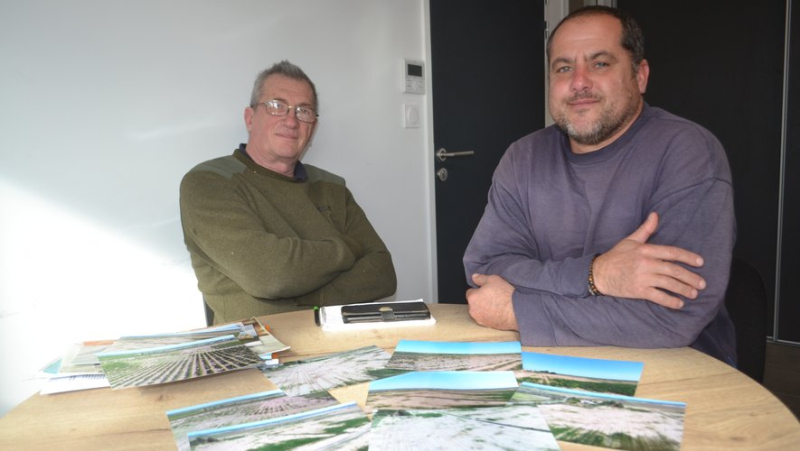Biterrois: faced with the salt that is eating away at their land, the farmers of the lower Orb plain are “not giving up”

Benoît d'Abbadie et Paul Thomas présentent les images des cultures impactées à l'été 2023 dans la basse plaine de l'Orb. Midi Libre – Mélissa Alcoléa
The fight continues for the winegrowers and farmers of the lower Orb plain, in Sérignan. Threatened by the salt which is killing crops, they have been mobilizing for several months to convince people of the absolute necessity of creating a dam on the Orb. Now with more than 230 members, their young association carried out a precise and edifying diagnosis of the impact of salt in the summer of 2003.
On this map of the lower Orb plain, i.e. 2,800 hectares of agricultural land (including 1,500 hectares of vines) from the sea to & nbsp;Sérignan but also Sauvian, Villeneuve-lès-Béziers and Portiragnes… the plots attacked by salt are represented in orange. So many spots which appear in whole flat areas or even more scattered as we move away from the coast. The predominance of color is nevertheless obvious.
"We carried out an inventory of the plot, a major survey of farmers installed on the Orb plain, we identified all the places where salt was observed, specifying the type of agriculture and the surface area affected, explains Paul Thomas, the president of the Intercommunal Association for the Defense and Protection of the Lower Orb Plain and vice-president of the Vignerons de Sérignan cooperative cellar. At his side, Benoît d'Abbadie, vice-president of the association, owner of 85 hectares in the area, is directly impacted: "Half of the 85 hectares has not been not been cultivated,” he says. "We pass the grinder through it to keep it clean…" And he is not the only one. Like this farmer who lost 17 hectares of seed corn in 2023. "This represents 100,000 € of losses", his colleagues advance.
300 farmers consulted
In total, some 300 farmers were consulted. "This represents two months of work, based on the cadastral matrix", explain the two men. Result: more than 200 hectares lost. "This allowed us to know where we are and this diagnosis will allow us to follow up." This small study completes the file compiled by the members of the #39;association campaigning for the creation of an anti-salt dam on the Orb, with a fish pass. The only way, according to them, to save these lands, otherwise doomed to die.
At the same time, they held more meetings with elected officials and institutions. "Since this summer, we have had more than 25 meetings with decision-makers, no one can say that they are not aware". To summarize: "We have the support of elected officials but they are waiting for the State to decide on the feasibility of the dam…" Their only ambition: "Stop salt" which goes back almost 20 kilometers in the Orb and propagates by capillarity in the adjacent lands. Over 6 meters deep and 60 meters wide, this gives "5 million m3 of brackish water".
"Is that where people die"
But the dam solution, "an automated border" which could lower in the event of flooding, comes up against a European directive and the Environmental Code which require the preservation of "ecological continuity" ; of the watercourse. The farmers respond with common sense: 'Even if it's stupid to throw fresh water into the sea, we accept it. But it is claimed that the Orb is no longer a watercourse and that it is the dam which will restore this continuity…"& nbsp;"We don't give up, that's it or people die. This is a position of no return. At the end of January, beginning of February, they have important meetings with representatives of the State and institutions. To be continued.
The Agglo hopes to finance a feasibility study of Cerema
Last July, the president of the Agglo Robert Ménard announced funding for a feasibility study. What about ? "We launched a call for tenders and we got no response,” he explains. "Only one responded, he withdrew, in relation to the legislation." "We discussed it again with the winegrowers and I discussed it with the prefect. And Cerema, a state organization, could carry out this study." The Agglo therefore intends to order and finance this study from Cerema. Which requires the prior agreement of the prefect. And on this subject, Robert Ménard seems optimistic. “We need this study to convince", he emphasizes again. And to develop a key idea: "Before, there was a natural dam (with the sediments present and which were exploited, Editor's note), the' idea is therefore to find the Orb as it was before being dredged, this argument must be heard by ecologists."
I subscribe to read more




